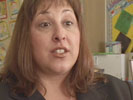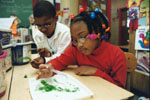Join us for conversations that inspire, recognize, and encourage innovation and best practices in the education profession.
Available on Apple Podcasts, Spotify, Google Podcasts, and more.
 “I really think that it’s during investigations that learning occurs. You know, when the children have the opportunity to make their own discoveries, their own explorations of their environment, it answers all those questions for them: the who, what, where, and why about how things are the way they are.”
“I really think that it’s during investigations that learning occurs. You know, when the children have the opportunity to make their own discoveries, their own explorations of their environment, it answers all those questions for them: the who, what, where, and why about how things are the way they are.”
LauraJo Kelly teaches second grade at Louis Marshall Elementary School in Brooklyn, NY. Her school, better known as P.S. 276, is part of the sprawling New York City Public School system, which annually sees over a million K-12 students taught by nearly eighty thousand teachers.
Located in southwest Brooklyn near Jamaica Harbor, P.S. 276 serves a largely minority population: about 89% of the students are African American with the remaining 11% divided roughly between Hispanic, Caucasian, and Asian children. About 74% of the school’s students are eligible for a free lunch.
Ms. Kelly remembers that when she first began teaching, the science curriculum her school was using was vague at best. “It would be magnets one week, and the next week we’d move onto seeds…I wanted something with more continuity.” That, combined with never having had a passion for science as a child herself, left her feeling like she wasn’t getting through to her students in science.
In her third year in the classroom she was asked to pioneer the SCIS curriculum in her school. She felt it was a huge improvement, more organized than her previous curriculum and with the added benefit that it spanned grades K-5, so that children came to her class with prior knowledge that she could work with. Now in her twelfth year of teaching, Ms. Kelly commented, “Science just became something that I loved, that I never loved as a child. As an adult I’ve become part of the Science Literacy Team, Science Leadership Team, where I help the other teachers teach science, and it just spiraled from there.”
 Lesson at a Glance:
Lesson at a Glance:
Curriculum: SCIS 3+, Lawrence Hall of Science, Delta Education
Grade: Second
Topic: Living, Dead, or Nonliving
From September to February, Ms. Kelly taught the first of two SCIS kits for 2nd grade, which covered physical interaction systems. The second kit, Life Science, began in March with organisms. From there it moved onto habitats and introduced the food chain before arriving at the lesson that was taped, “living, dead, and never-living.”
In the lesson, Ms. Kelly introduced the students to a number of living organisms and guided them in a discussion about classification. What makes something “living,” “dead,” or “never living”? After discussing essential characteristics of each category, Ms. Kelly distributed a mystery material, the “green stuff,” and asked her students to determine what category it belonged to.
Through that inquiry exercise, her students developed their ideas and, along the way, surprised their teacher: “I thought they would all agree that it wasn’t alive. I thought they would say that it was plastic since it doesn’t move and doesn’t do anything — but they really looked very closely.” And it’s a good thing they did. The “green stuff,” it turns out, was an air fern.
 Lesson Goals:
Lesson Goals:
Students invent the concepts “living,” “dead,” and “nonliving.”
Students group objects as living, dead, or nonliving.
Students test objects to determine if they are living.
Consider the goals for this lesson as listed above. How can you create a lesson appropriate for your classroom that will fulfill similar goals?